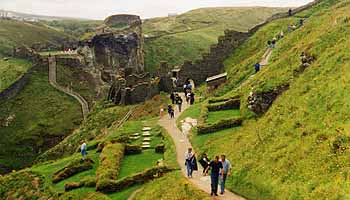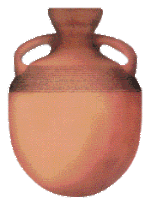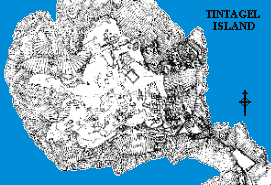 |
 |
|||
|
|
Though it is always said that King Arthur was born at Tintagel, early literary sources only ever actually say that he was conceived there. The rest is presumed or implied. But is Tintagel Castle really that old? Tradition: Geoffrey of Monmouth first told us of King Arthur's association with Tintagel Castle in 1139 when he wrote his History of the Kings of Britain. Duke Gorlois of Tintagel lived at the Castle. One day, he brought his young wife, Igraine, to the court of his High-King, Uther Pendragon of Britain, in London. Uther fell deeply in love with the beautiful Igraine and determined to have her for his own. Gorlois noted the attention paid by the King to his wife and returned to Kernow (Cornwall). Upon being summoned back to court, Gorlois refused to return and quickly found his lands invaded by his overlord. Igraine was hidden away in the impregnable Tintagel, while Gorlois himself defended the nearby stronghold of Dimilioc. Uther, meanwhile, persuaded his magician, Merlin, to turn him into the likeness of Gorlois. Using this disguise, he slipped into Tintagel Castle unhindered and seduced Igraine. That night, their son, the future King Arthur was conceived. Gorlois was killed the next day and Uther and Igraine quickly became husband and wife. Ancient Propaganda & Patronage: Though the majority of Tintagel Castle was built by Prince Richard, Earl of Cornwall, in the 1230s, it is believed, by many, that an earlier castle was first constructed here by Earl Reginald around 1141. This latter Earl of Cornwall was brother to Geoffrey of Monmouth's patron, Prince Robert, Earl of Gloucester. So perhaps it was included in the story merely to win Royal favour. Modern opinion, however, tends to support a scenario whereby Reginald built the castle to cash in on the prestige created by Geoffrey's work. William of Worcester first recorded that King Arthur was born at Tintagel in 1478. It is a simple assumption to step from conception to birth.
Possible Interpretations: Radford's excavations of the 30s were explained, at the time, as having revealed the cells and out buildings of a Post-Roman Monastery complex. This theory has been swept aside by Modern archaeologists. The name of the place itself, Din-Tagell meaning Fort of the Constriction, indicates a secular residence. The high levels of expensive pottery imported to the site from the Eastern Mediterranean indicate it was under the control of an important chief with access to large amounts of tradable commodities, probably Cornish Tin. In fact, just such a man as Gorlois, the supposed Duke of Tintagel, or King Mark of Kernow (Cornwall) who is also associated with the island. One could easily have followed the other at Tintagel. Such an exposed Dark Age Palace must surely have been the Summer residence of the Kings of Kernow (Cornwall) and Dumnonia. Though their main feasting hall has not been located, it is thought to lay beneath the ruins of the medieval castle. Thomas has suggested adjoining areas of high-status, specialist and war-band occupation. Also a marine landing site and caretaker's residence. The later chapel may originally have been a secular building, though the early dedication to King Brychan of Brycheiniog's son, St. Juliot alias Iltud probably indicates it was always the Dumnonian Chapel Royal.
|
|||
| © Nash Ford Publishing 2001. All Rights Reserved. | ||||





 TINTAGEL CASTLE
TINTAGEL CASTLE Modern
Archaeology: Extensive
excavations undertaken by Radford on Tintagel Island in the 1930s revealed
that there was indeed Dark Age occupation around Tintagel Castle. Some
twenty plus rectangular stone buildings were uncovered along terraces on
the eastern slopes of this promontory, and on the plateau around the
Castle Chapel (dedicated to St. Juliot). The discovery of huge quantities
of 5th and 6th century Mediterranean pottery amongst these ruins led to
their being dated to this period. There was more pottery than the total
haul from all other Dark Age sites in Britain: huge Tunisian oil jars,
Carthaginian dishes, Aegean amphorae and distinctive Byzantine jars.
Modern
Archaeology: Extensive
excavations undertaken by Radford on Tintagel Island in the 1930s revealed
that there was indeed Dark Age occupation around Tintagel Castle. Some
twenty plus rectangular stone buildings were uncovered along terraces on
the eastern slopes of this promontory, and on the plateau around the
Castle Chapel (dedicated to St. Juliot). The discovery of huge quantities
of 5th and 6th century Mediterranean pottery amongst these ruins led to
their being dated to this period. There was more pottery than the total
haul from all other Dark Age sites in Britain: huge Tunisian oil jars,
Carthaginian dishes, Aegean amphorae and distinctive Byzantine jars.